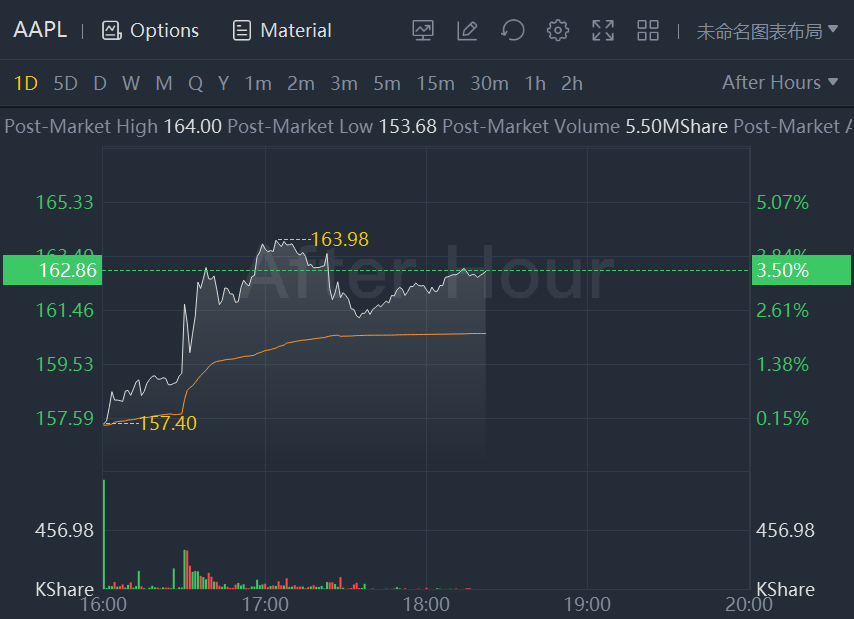July 28 (Reuters) - Apple Inc on Thursday said parts shortages are easing and that demand for iPhones is unceasing despite consumers tightening other spending, helping it top Wall Street expectations and forecast faster sales growth ahead.
The Silicon Valley giant's shares rose 3.5% after hours following the release of the results. Apple said it was not providing specific revenue guidance due to economic uncertainty.
Though macroeconomic indicators around the world are turning negative, Chief Financial Officer Luca Maestri told Reuters there had been no slowdown in demand for iPhones. The iPhone maker's loyal and relatively affluent customer base has enabled it to weather dips better than other consumer brands in the past, and the results for Apple's fiscal third quarter suggest a similar pattern emerging.
Canalys Research analyst Runar Bjorhovde said, "Apple in that sense has a certain robustness that will allow it to be impacted less than a lot of its competitors."
The slumping economy is hurting sales of advertising, accessories and home products, though, Apple's Maestri said in an interview, calling the units "pockets of weakness."
"Fortunately, we have a very broad portfolio, so we know we're going to be able to navigate that," he added.
Parts shortages will continue to limit Mac and iPad sales, Maestri said, though the impact has been easing. They cost Apple under $4 billion in sales in the quarter ended June 25, less than it had forecast. Maestri said the company expects the hit to diminish further in the current quarter.
Sales compared to a year ago should rise faster in the current quarter than 2% growth it posted in the just-ended quarter, Maestri said.
Overall, Apple said quarterly sales and profit were $83.0 billion and $1.20 per share, above estimates of $82.8 billion and $1.16 per share, according to Refinitiv data.
While sales of iPhones and iPads topped expectations, revenue from services, Mac computers and accessories missed Wall Street targets and sales in the crucial China market fell 1%.
The rising U.S. dollar has hit many companies such as Apple that generate substantial foreign revenue and are getting less cash back when they convert it. Apple said currency fluctuations would slash sales by 6% in the current quarter.
The most recent economic woes include supply chain disruptions that have hit production of some Apple products such as iPads and Macs whose assembly locations were clustered near regions of China that went into COVID lockdowns.
Apple, like many of its tech industry peers, is reportedly slowing hiring and cutting costs given the tough economic climate.
Apple shares closed Thursday down about 11% so far this year, slightly less than the broader S&P 500 index and also less than other consumer hardware makers such as Sonos Inc and Samsung Electronics Co.
Apple said iPhone sales were $40.7 billion, up about 3% from a year earlier and well ahead of the overall global smartphone market, which fell 9% during the just-ended quarter, according to Canalys data.
Growth in the company's services business, which has provided a boost to sales and profits in recent years, was 12%, below the previous year's 33% rate and resulting in $19.6 billion in revenue, below estimates of $19.7 billion.
Apple said it now has 860 million paying subscribers on either its paid services or to paid software in its App Store, up from the previous quarter's 825 million.
Sales of iPads and Macs were $7.2 billion and $7.4 billion, compared with estimates of $6.9 billion and $8.7 billion. Mac sales represented a 10% contraction, after record sales since 2020, first from a work-from-home boost and then from Apple's new proprietary processor chips.
In its most recent fiscal year, nearly a fifth of Apple's sales came from its Greater China region after two years of struggling sales there. But now Apple is confronting slow overall economic growth in China, where its fiscal third-quarter sales were $14.6 billion, down 1%.

Comments